SpaceX launches Earth-observation satellite for Argentina, nails rocket landing
It was a rare polar launch from Florida, the first since 1969.
CAPE CANAVERAL, Fla. — SpaceX successfully launched an Earth-observation satellite for Argentina along with two small piggyback satellites today (Aug. 30).
The trio blasted off from Space Launch Complex 40 here at Cape Canaveral Air Force Station at 7:18 p.m. EDT (2318 GMT).
A used two-stage Falcon 9 rocket carried the SAOCOM-1B satellite aloft, marking the company’s 15th launch of 2020. Approximately nine minutes after liftoff, the booster's first stage produced some dramatic sonic booms as it made its way back to terra firma, touching down at SpaceX’s Landing Zone-1 (LZ-1) at Cape Canaveral.
Related: See the evolution of SpaceX's rockets in pictures
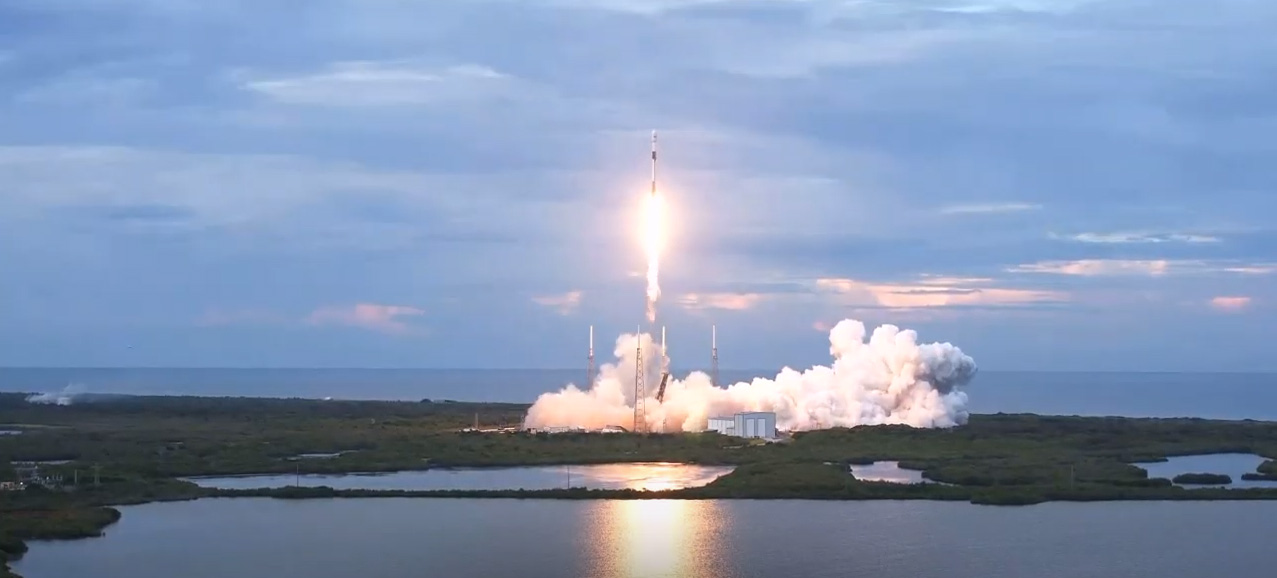
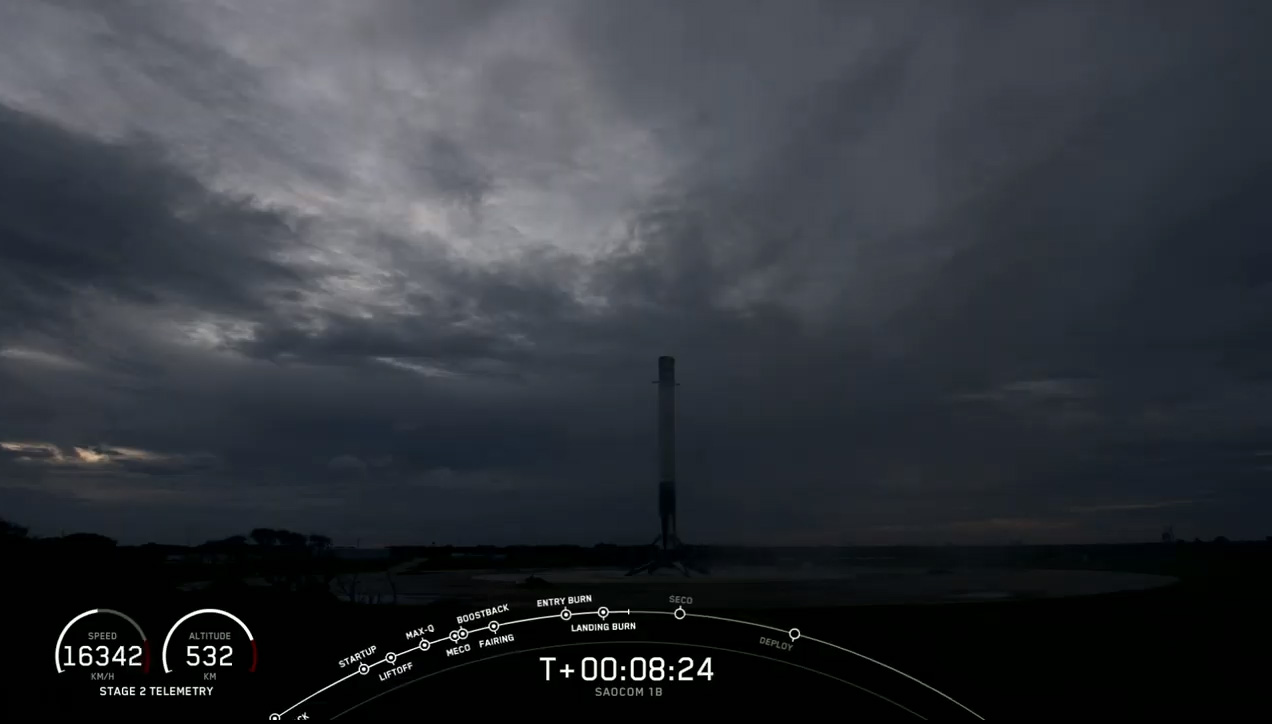
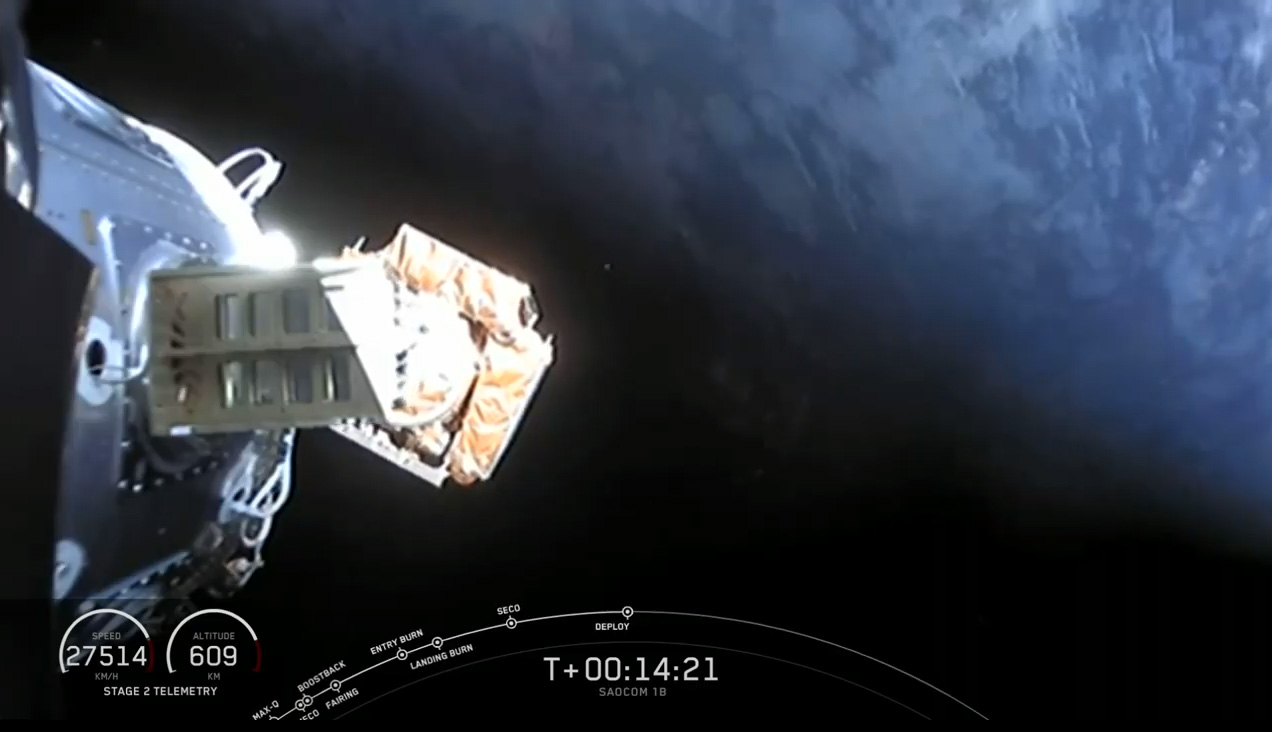
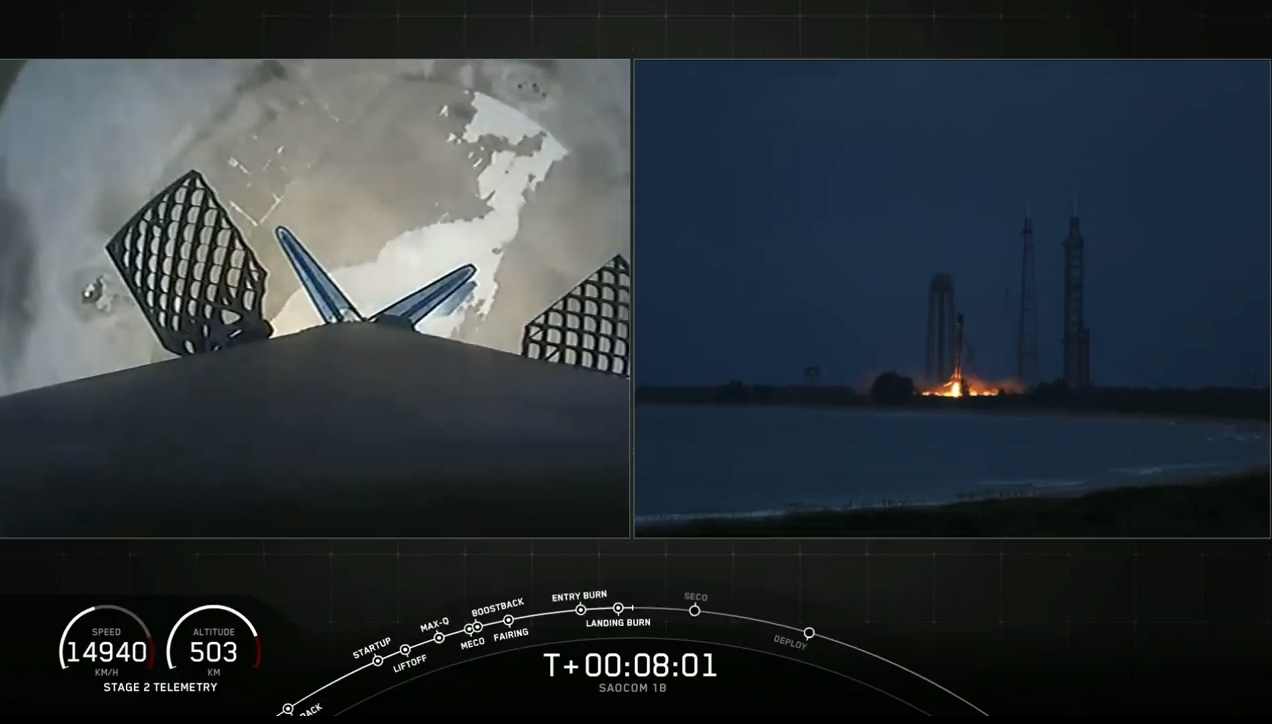
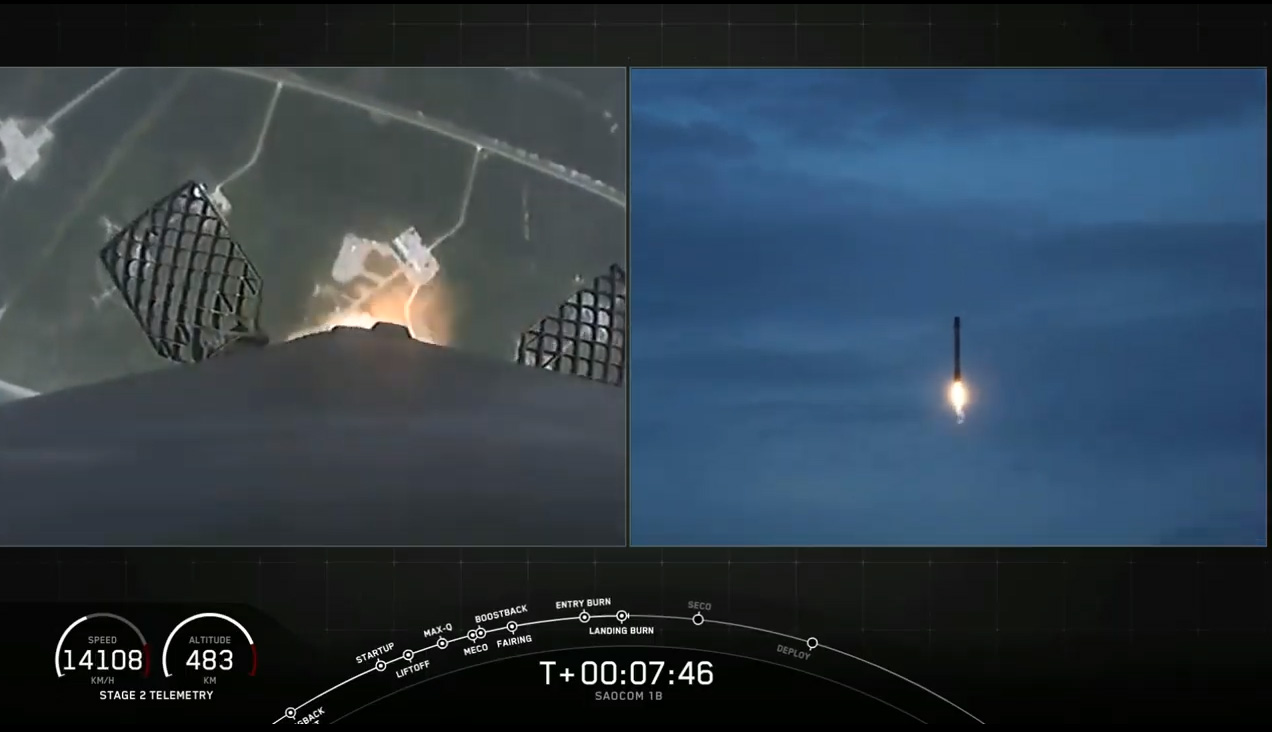
Today’s flight was the fourth launch for this particular Falcon 9 first stage. The booster, designated B1059, previously lofted two commercial cargo missions to the International Space Station for NASA and delivered a batch of SpaceX Starlink satellites into orbit earlier this year.
The Falcon 9 appeared to launch straight up as it climbed to orbit. The skies above the space coast were cloudy but you could hear the Falcon 9 long after it was out of sight.
Thick clouds made it hard to track the first stage on its downward trek. Suddenly it appeared in the sky, with the iconic sonic booms you expect cracking overhead as the booster descended to the landing site.
Get the Space.com Newsletter
Breaking space news, the latest updates on rocket launches, skywatching events and more!
SAOCOM-1B deployed from the Falcon 9's upper stage as planned 14 minutes after liftoff. The two rideshare satellites, GNOMES-1 and Tyvak-0172, were scheduled to deploy about an hour after launch.
Scuttled doubleheader
SpaceX had planned for a launch doubleheader today, intending to launch two different Falcon 9 rockets just hours apart.
Up first was a big batch of SpaceX's Starlink broadband satellites. That mission was supposed to blast off this morning from Pad 39A at NASA’s Kennedy Space Center, next door to Cape Canaveral, but poor weather conditions prevented the company from finishing its launch preparations, and the team was forced to stand down. That launch has been rescheduled for Tuesday (Sept. 1) at 9:29 a.m. (1329 GMT), pending approval of the Eastern Range, the entity that oversees all launches along the East Coast.
But Mother Nature cooperated for the SAOCOM-1B mission. The main payload on board the veteran Falcon 9 is the SAOCOM-1B radar Earth-observing satellite, launching for Argentina's space agency, the Comisión Nacional de Actividades Espaciales (CONAE).
SAOCOM, short for Satélite Argentino de Observación COn Microondas (Argentine Microwaves Observation Satellite), is a two-satellite program with a total price tag of about $600 million, including launches. SpaceX lofted the first SAOCOM spacecraft, SAOCOM-1A, from Vandenberg Air Force Base in California in October 2018.
The SAOCOM-1B mission had been delayed since March due to the ongoing COVID-19 pandemic.
Both SAOCOM satellites launched into a polar-orbiting trajectory that allows them to fly over the planet’s poles. This type of mission typically flies from the West Coast. In fact, the SAOCOM-1B mission was the first satellite launched into a polar-orbiting trajectory from Cape Canaveral since 1969. That’s because of an incident that happened in late 1960, when debris from a Thor rocket reportedly fell on Cuba and killed a cow.
Officials were able to greenlight this type of mission from Florida, but only if the rocket had an automated flight termination system, which the Falcon 9 does. For the SAOCOM-1B mission, the Air Force secured a trajectory that flies south, over Cuba, while the rocket’s first stage returned to land at Cape Canaveral.
Rocket recovery
The first stage of the Falcon 9 featured in today's mission is now a four-time flier, as it previously launched two SpaceX cargo missions — CRS 19 in December of 2019 and then CRS-20 in March of this year. These two missions launched the final Dragon 1 resupply capsules. From this point forward, cargo will travel to the space station in the same model spacecraft that SpaceX uses to transport astronauts.
B1059 is only the second booster to land on terra firma this year. In fact, it’s the second trip to LZ-1 for this booster, as the veteran Falcon 9 first stage also returned to land after delivering the CRS-20 mission into orbit.
This is SpaceX’s 42nd reflight of a Falcon 9 since the company recovered its first booster in 2015. It also marks the 59th landing of a Falcon 9. To ace the touchdown, the booster separated from its upper stage and conducted a series of orbital ballet moves, reorienting itself for landing. Then it conducted a series of three engine burns to slow itself enough to gently touch down on terra firma.
SpaceX has two massive drone ships it uses to recover the majority of its rocket boosters. Named "Of Course I Still Love You" and "Just Read the Instructions," the floating platforms are typically stationed out in the Atlantic Ocean and have enabled SpaceX to launch and subsequently land more rockets.
Once they're back in Florida's Port Canaveral, the landed boosters are transported back to SpaceX facilities, where they're carefully inspected and repurposed to fly again.
The current iteration of the Falcon 9 was finalized in 2018. Known as the Block 5, it features 1.7 million pounds of thrust as well as some other upgrades that make it capable of rapid reuse. SpaceX says that each of these boosters can fly as many as 10 times with minor refurbishments in between, and potentially as many as 100 times before retirement.
To date, SpaceX has launched and landed the same booster a maximum of six times.
Related: SpaceX launches Starlink satellites, lands rocket in dazzling nighttime liftoff
Fairing reuse
Ahead of today's launch, SpaceX deployed its twin fairing catchers, GO Ms. Tree and GO Miss Chief. These two boats act as giant, mobile catcher's mitts, snagging payload fairings — the protective nose cones that surrounds satellites during launch — in their attached nets as they fall back down to Earth.
Whether or not the boats are able to make a catch depends on many factors, including the weather. Today, one ship was deployed to recover the SAOCOM-1B fairings and the other was sent out for the Starlink mission.
SpaceX has installed parachutes and special software in its payload fairings, which consist of two joined pieces. The fairings therefore can guide themselves to a designated recovery zone where Ms. Tree and Ms. Chief can wait to snag them as they fall back to Earth. If the boats miss or the weather is too poor to attempt a catch, the duo has on board equipment to scoop the fairing pieces up out of the water and carry them back to port for refurbishment.
Today was a scoop day; there would be no attempt to snag the falling SAOCOM-1B fairing halves before they hit the water, SpaceX launch commentators said shortly before liftoff.
Next up for SpaceX will be the Starlink mission it hoped to launch today. That flight, which is the 12th Starlink launch, will deliver 60 of the internet satellites to orbit.
Follow Amy Thompson on Twitter @astrogingersnap. Follow us on Twitter @Spacedotcom or Facebook.
Join our Space Forums to keep talking space on the latest missions, night sky and more! And if you have a news tip, correction or comment, let us know at: community@space.com.

Amy Thompson is a Florida-based space and science journalist, who joined Space.com as a contributing writer in 2015. She's passionate about all things space and is a huge science and science-fiction geek. Star Wars is her favorite fandom, with that sassy little droid, R2D2 being her favorite. She studied science at the University of Florida, earning a degree in microbiology. Her work has also been published in Newsweek, VICE, Smithsonian, and many more. Now she chases rockets, writing about launches, commercial space, space station science, and everything in between.









